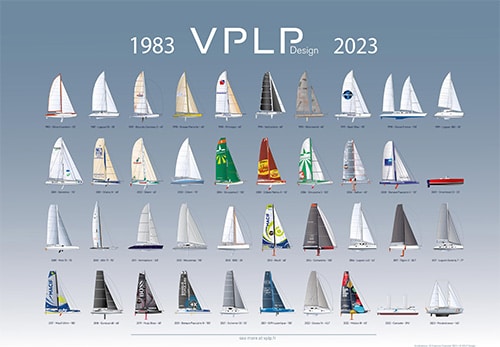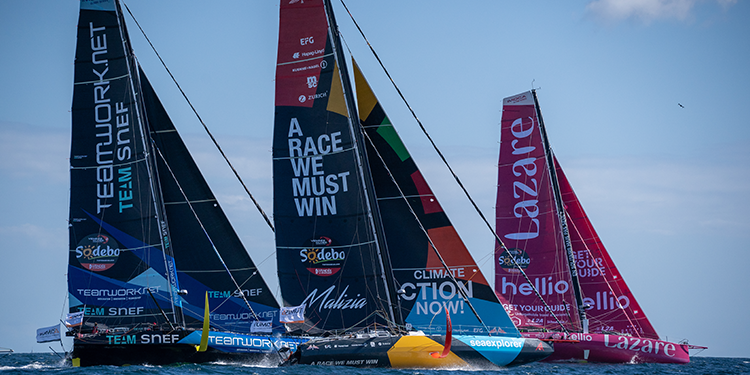Looking to develop a fast sailing ship to provide a shipping service between Europe and the USA, the French start-up VELA asked VPLP Design to explore the range of possibilities in the fledgling sector of zero-carbon transport of goods by sea. This led to the design of a 65 m schooner-rigged trimaran which can carry 350 tonnes between Nouvelle-Aquitaine (France) and New York in under two weeks, including loading and unloading. We talk to Simon Watin, partner in charge of VPLP Design’s Shipping Division, and Tanguy Leterrier, lead architect on the project.
During the early discussions between VELA and VPLP Design in autumn 2022 it became clear that the ambition of the start-up’s five founders – François Gabart, Pierre-Arnaud Vallon, Thibault Charles, Michaël Fernandez Ferri, Pascal Galacteros – was to be able to promote a fast sailing ship that could cross the North Atlantic in under two weeks. In comparison, a conventional freighter covers the same route in twenty days, loading and unloading included. VELA was adamant that VPLP were to exclude nothing, to explore every possible architectural innovation, including solutions that have hitherto never been tested in the context of shipping.
“Inevitably you have to focus on building very large vessels,” says Simon Watin, Partner Naval Architect and head of VPLP Design’s Shipping Division. “So you need a lot of power and a considerable righting moment to ensure good speeds.” While monohull designs are undoubtedly best for heavily laden vessels, multihulls become the natural choice when the volume of the cargo is of greater consideration than its density. “And in the case of multihulls, a trimaran is better than a catamaran because its better longitudinal structure allows you to carry the largest possible sail plan without having to double up on all the systems,” says Simon Watin.
To validate the concept, VPLP Design felt it necessary to create two virtual vessels that could be put through numerous digital simulations and, in collaboration with the team at MerConcept, routing scenarios between Europe and North America. “A 60 m monohull with two decks and a 65 m trimaran with transverse loading,” says Tanguy Leterrier, VPLP Design’s lead architect on the project. “With the latter we managed to make significant gains on a crossing with the same payload, about 350 tonnes, which is equivalent to 560 standard European pallets or 450 US pallets.”
A Real Sailing Ship that is
fast and self-contained
And the result was VELA, a two-masted schooner with a 25 m beam and an onboard crane. She will always dock port side to and will be completely independent when it comes to loading and unloading, an especially important feature when calling at secondary ports along her route. The floats stabilize the platform while the centre hull supports the majority of the displacement. Much of the difficulty resided in finding the right geometry and distribution of the volumes to ensure that the floats remain in contact with the water when the ship is sailing empty. “We wanted to avoid installing the complex ballasting systems that are the bane of the freighter, and which can contribute to spreading invasive species,” says Simon Watin. Aluminium was chosen for the hull material because of the significant weight savings it affords compared to a conventional steel construction, without falling short of the requirements of a working vessel in terms of structural strength.
This desire for simplicity does not exclude compliance with the rigorous standards of the merchant marine, governed by the International Convention for the Safety of Life at Sea (SOLAS). “That’s why many boats, such as the Grain de Sail 2 built by the Piriou yard in Concarneau, are limited to 500 gross tons, which is a threshold between two regulatory regimes,” says Tanguy Leterrier. With a capacity greater than 1000 gross tons, VELA has to comply with the strictest of standards. Initial discussions with the French maritime authorities and ship classification organizations to define the regulatory framework which will govern the operation of this new type of ship were also an integral part of the architectural studies.
The team commissioning VELA want the vessel to sail under the French flag, with a permanent salaried crew, and are currently exploring the possibility of having her built in Metropolitan France. “Several yards have the capacity to undertake this kind of aluminium construction. The ship’s beam reduces the number of potential candidates, so assembly could still be performed outside France,” says Simon Watin. Nothing has been set in stone for the rigging either, including the 47 m masts which both culminate at 55 m above sea level. They could be aluminium, given the generous angles a trimaran offers, “but they will have to be custom made because mast extrusions of this size don’t exist off the shelf,” says Simon Watin.
Scheduled for launch in 2025, VELA is “the fruit of an excellent collaboration with people who are looking for something different and who give precious leeway to designers,” says Simon Watin. For the start-up team, several more months’ work will be needed to complete the design. The ultimate goal is to establish a fleet of freight trimarans offering as yet unparalleled performance at sea.






